By Jeff Yago, P.E., CEM
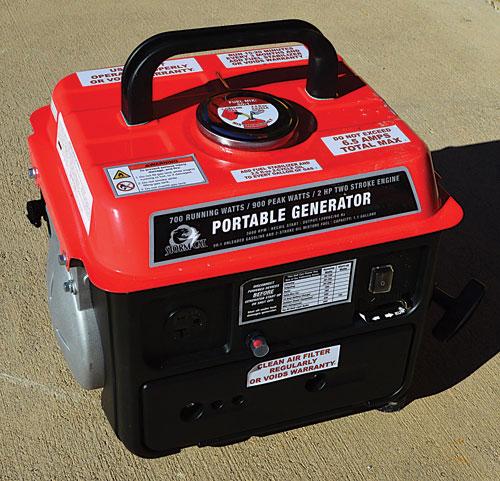
While I strive in all of my articles to only recommend products of high quality and reliability, I realize many of us are on a fixed-income or have limited budgets for emergency preparation. When it comes to backup generators, I own several larger ones.
However, I also recommend owning a smaller portable generator in addition to any larger backup generator you may already own. They can power most of your critical loads using very little fuel, yet can be carried with one hand if you are forced to evacuate or relocate to an alternative location.
While a generator rated at 1000 watts or less may not be able to power your toaster, coffee pot, or microwave oven, they can keep a residential refrigerator operating by running about two hours in the morning and two hours in the evening (while also powering your television, radio, a few LED lights, and perhaps recharging a few battery-powered devices) with only one gallon of gas per day. The larger contractor and whole-house generators may have the capacity to power all of your electrical loads, but this is little comfort if your fuel supply only lasts a few days. At a one-gallon consumption per day, a 1000-watt backup generator can operate an entire week on the fuel a larger generator would use in less than a few hours — something to think about when facing a potential grid-down event.
In this under 1000-watt size range, there is a small gasoline generator being marketed by Harbor Freight. The Storm Cat 800-watt (900-watt peak) generator has a huge following on YouTube with videos describing their operation and suggested modifications to make as soon as you open the box. Many owners feel its extremely low price is the reason several needed features were left off, while others have a love-hate relationship with this little generator. While I am not going to recommend readers run out and buy one tomorrow, I do think it might be worth a closer look, especially for those with limited cash.
I actually paid only $89 for this generator, which normally sells for $135, using a magazine coupon at a Harbor Freight store located in a nearby city, which saved the shipping cost.
Before making my purchase, I watched many of the YouTube videos made by Storm Cat owners describing the importance of following all break-in procedures, plus several showing how to make modifications they felt were necessary even before the first startup. I strongly recommend following all operating and safety information provided in the owner’s manual. I do not recommend making any modifications described in the YouTube videos unless you are very familiar with working on small engines.
I noticed in the YouTube videos that owners were making modifications to Storm Cat 800-watt generators that were blue in color, while all current models of this generator are red in color. It’s possible many of the modifications they were making may have been for problems that have been resolved with the updated red version of this generator.
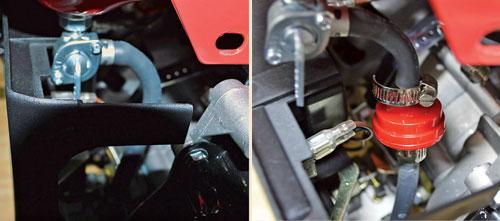
This generator has a two-cycle engine, while almost every other generator on the market has a four-cycle gasoline or propane-fueled engine. That means you must use an oil additive in the gasoline. The Storm Cat owner’s manual was very specific that all gasoline must be fresh, have an octane rating of 87 or higher, be unleaded, use a 50-to-1 gas to oil ratio, and have a octane stabilizer added to each fill-up regardless of summer or winter operation. My prior and very costly repair experience using ethanol-blended gasoline in multiple two-cycle chain saws and weed-eaters makes me strongly advise to never use ethanol-blended gasoline in any small two- or four-cycle gasoline engine, even if the owner’s manual indicates it is acceptable.
At first I was somewhat reluctant to buy any generator with a two-cycle engine, but this can actually be an advantage with a generator this small and lightweight since it has no crankcase oil and is totally dry when the gas tank is empty. This means it can be stored almost anywhere and even packed away until needed without leaking oil or gas onto vehicle carpeting or the storage area floor, as long as the fuel tank stays empty. With a generator this low in price, the initial break-in process is extremely important. This 800-watt generator has a one-gallon gas tank and will run between four and six hours, depending on load.
The break-in period is 25 hours and during this time, the actual load should not exceed 300 watts. Most owners suggest only powering a 100-watt load during the first two tank fill-ups for the initial break-in period. This means the break-in process will consist of a total of five fill-ups of one gallon each, while allowing the generator to run each time until out of gas. For my first five hours of initial break-in I did not power any load. For my next two fill-ups I powered a 100-watt light bulb. During my final two fill-ups, I limited the load to 300-watts of incandescent light bulbs only. After each fill-up, I started the generator in the afternoon and let it run until out of gas, then repeated the process each day for several days.
Most of the YouTube videos suggested the spark plug shipped with the generator would not last long, and should be replaced with a Autolite #65 or NGK #BPR6ES spark plug as soon as you open the shipping box. My generator started on the second pull right out of the box, so perhaps this spark plug concern was more of an issue with the older blue color generator models. I do plan to order a higher-quality replacement spark plug and change it out after my first 50 hours of run time.
Another issue with any two-cycle gasoline engine is making extra sure the fuel is clean and fresh, as any contaminates will quickly block the tiny carburetor orifices and reed-type fuel intake valve. The Storm Cat generator comes with a fuel line that runs straight down from the bottom of the fuel tank right into the carburetor located directly below. This is also a straight route down for any contaminates in the fuel that may settle in the bottom of the tank. I strongly recommend installing an in-line fuel filter in this fuel line as soon as you buy the generator and before operating the first time.
This modification is demonstrated in multiple YouTube videos and is very easy to do. Since there is limited space, you will need a fuel filter that is very short between the inlet and outlet, and has a limited pressure drop since there is no fuel pump. I found the Briggs & Stratton #2980905 fuel filter for under $5. It was designed to fit lawnmower engines which have small fuel lines and no fuel pump.
It’s easier to access this engine area if you remove the fuel tank and front air cleaner cover. Several of the YouTube videos recommend tightening all engine bolts before your first startup. I skipped this recommendation, but when I installed the fuel filter after my first two fill-ups, I noticed many of the access bolts I had to remove to install the fuel filter were actually fairly loose. I feel checking all bolts for tightness is probably a good recommendation to follow, especially for a generator costing only $89.
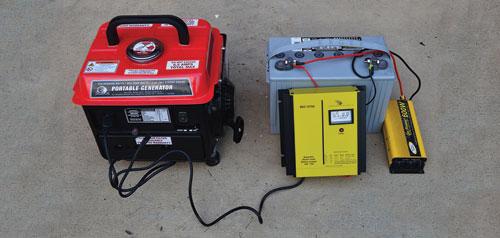
Testing and operation
If you were planning to buy this little generator to power your high-end audio and video equipment, you may want to reconsider. Unlike more expensive generators that include electronic voltage regulation, the voltage output of this bare-bones generator is much less regulated. Without any connected load, I found the output voltage to constantly drift from 110 volts up to 130 volts. However, as you add load the generator voltage output starts to stabilize around 122 volts. I never could get the frequency to match the 60-cycle utility standard frequency as it would drift between 58 and 65 cycles per second until more load is added, then it also settled down to a fairly constant 62 cycles. While this should not affect most small electrical appliances or lights, I would hesitate to power more sensitive electronic devices if they require a utility-grade power quality.
I had hoped to make this little generator part of a small emergency backup system by adding a small UPS battery power unit typically sold for desktop computers. I thought this would improve the power quality from the generator and allow powering small radios and LED lights on backup power while only running the generator a few hours each day to recharge the battery in the UPS unit. However, most computer backup units are designed to monitor the grid input voltage and frequency and switch to battery backup immediately if the grid voltage or frequency go out of limit, as well as completely off. With the less regulated output voltage and frequency of the Storm Cat generator, I could never get any of my computer UPS units to stay on-line and recharge their internal batteries using this generator.
However, I did find portable 10-amp automotive-type battery charges were much less particular on input power quality, and will keep a 12-volt RV/marine battery charged using this generator. My recommendation is to use this generator a few hours each day during a power outage to power a refrigerator while charging a deep-cycle battery. You could then use the fully charged RV/marine battery at night to recharge cell phones, portable radios, or LED lanterns that have 12-volt DC charging adaptors during an extended utility power outage.
While most laptop computers have 12-volt adaptors that will allow operating from a RV/marine battery, some electronic devices may not work properly or could even be damaged when directly powered by this less regulated generator. If in doubt, check the owner’s manual.
While I will continue to rely on my larger generators for emergency power at home, I plan to take this little 38-pound generator with me when camping or heading to a remote weekend cabin. I keep the generator’s gas tank empty, but keep two separate three-gallon gas cans nearby containing a 50-to-1 gas/oil mix of quality non-ethanol gasoline. Both gas cans also contain a fuel stabilizer, and I rotate these gas cans with my chainsaw and weed eater fuel cans to keep them fresh.
I also own an almost identical-sized Honda 1000i generator, which I trust more than the Storm Cat generator to power my sensitive electronic equipment, as it includes the built-in “inverter” feature which holds a very stable 120-volt and 60-cycle frequency output as the load changes. However, it did cost eight times the cost of my “Storm Cat,” so you usually get what you pay for. While a two-cycle engine can be easily flooded then hard to start, I have found my four-cycle Honda generator at times to also be temperamental and hard to start, especially if I do not use it regularly. You need to properly maintain any generator, regardless of size or cost.
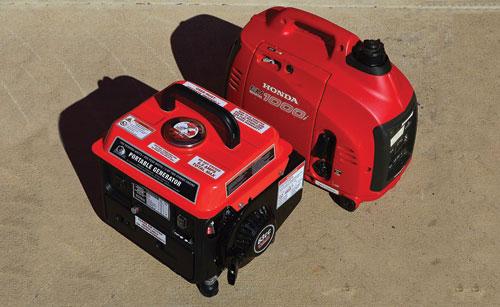
Conclusion
While I am quite pleased with my $89 generator investment, I recommend that you watch some YouTube videos before making your decision. While the 800-watt Storm Cat generator is noisy, its power quality is not suitable for sensitive loads, and it requires mixing oil with the gas, it’s still cheap. If you avoid leaving any gas in the fuel tank or carburetor when not actually in use and always add fresh fuel per the manufacturer’s instructions, it should provide a reasonable level of emergency backup power while being cheaper than any other generator on the market.
If you want an almost identically-sized generator that is much quieter, does not require mixing oil with gas, and will provide a very stable voltage and frequency to power sensitive electronic devices, then the Honda 1000i is a better choice. In addition, the Yamaha 1000i is also a highly-rated generator and is almost identical in size and features as the Honda 1000i. Both of these higher-quality generators sell for around $800.
[weaver_widget_area id=’articles_about_yago’ class=’text3′]


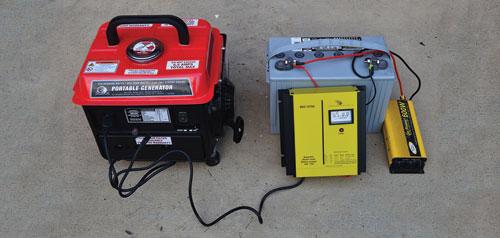














I bought a storm cat I was out camping I guess the light I brought was alot more than I thought
it poped the over load button 3 times wellI felt something snap and the button wouldn’t work anymore and it wouldn’t start either this the information I got off the part KUYUH 88 SRRIES
8A I’m sure your familure with it. 6233401312